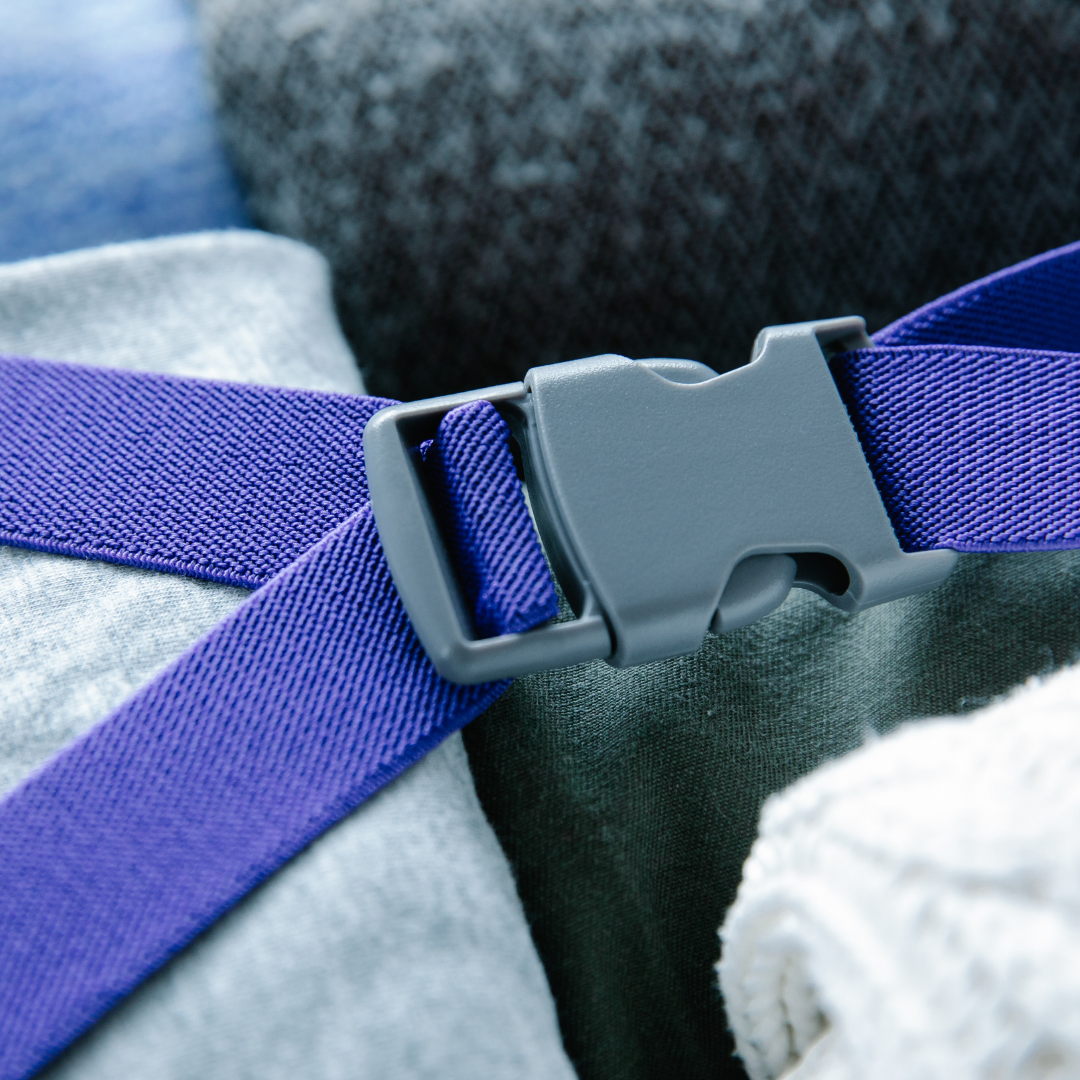Buckles and Sliders 101: A Designer’s Guide to Choosing and Using Adjustable Fasteners
Adjustable fasteners like buckles and sliders play a key role in sewn product design by providing secure, versatile, and user-friendly closures. Whether you're creating functional outdoor gear or fashion-forward accessories, understanding when and how to use these components can improve both performance and style.
These fasteners are especially useful when you need a reliable adjuster, from delicate lingerie straps to heavy-duty equipment closures. Buckles and sliders provide customization and control over fit, hold, and release, making them essential across a range of products, including:
Bags and backpacks
Belts and harnesses
Outdoor and safety gear
Pet collars and leashes
Athletic wear and activewear
Bras, bathing suits, and lingerie
Adjustable dresses and garments
Part 1: The Basics of Working with Buckles and Sliders
Buckles and sliders offer secure closures with a customizable fit, making them a go-to choice for many sewn products. Buckles are especially valued for their quick-release options, which add convenience for users who need fast access or adjustments. In load-bearing applications like backpacks or safety harnesses, their strength and reliability stand out. Additionally, these components are known for their durability and reusability, often withstanding repeated use with minimal wear over time.
How Do Buckles Work?
Buckles are designed to fasten two ends of material together securely. Depending on the style, they may lock, clip, or snap into place, providing a firm hold that can handle significant tension or weight. Many buckle types also feature one-handed release mechanisms, making them both functional and user-friendly, especially in applications where speed and ease of use are essential.
How Do Sliders Work?
Sliders function by allowing users to adjust the length and tension of straps. This is achieved by feeding the webbing through one or more slots or bars, where the friction or shape of the slider holds it in place. The result is a smooth, precise fit that can be customized as needed, whether for comfort, security, or performance.
Part 2: Types of Buckles and Sliders in Sewn Product Design
Buckles and sliders come in many varieties to suit your material choices, use cases, and visual style.
Buckle Types
Side Release Buckles
Side-release buckles are among the most recognizable and widely used types. These two-part plastic buckles click together securely and open by pressing side tabs, making them convenient for quick-release needs. They are commonly found on backpacks, dog collars, and utility belts due to their ease of use and reliable hold.
Cam Buckles
Cam buckles feature a spring-loaded lever that grips the strap securely when tension is applied. Known for their strong hold and easy release, they’re ideal for applications that require tensioning, such as tie-down straps, belts, and utility equipment.
Center-Release Buckles
Center-release buckles open by pressing a central mechanism, providing a secure closure that’s easy to release. These are commonly found in safety vests, chest harnesses, and workwear where quick access and a strong hold are both required.
Belt Buckles
You are already familiar with these! Belt buckles use a tongue-and-frame design made from metal, often seen in fashion accessories like belts and bag handles. They offer a timeless, rugged aesthetic and are well-suited for thicker materials that don’t bend well.
Magnetic Buckles
Magnetic buckles use internal magnets to snap together, enabling quick, one-handed operation. This modern, user-friendly design is popular in baby carriers, sportswear, and high-end tech accessories where convenience meets sleek styling.
Slider Types
Sliders allow users to fine-tune strap lengths and secure loose webbing ends. These components are essential for making sewn products adjustable and comfortable.
Tri-Glide Sliders
Metal or plastic, tri-glide sliders (also known as three bar slides, tri-slides or strap adjusters) are commonly found on backpacks, overalls, and crossbody bags. They work by feeding the loose strap end through one slot, over the center bar, and back through the second slot. The friction holds the strap in place, and you can slide it to tighten or loosen as needed.
Ladder Lock Sliders (also referred to as buckles)
Ladder lock sliders (buckles) are simple, lightweight sliders that allow for one-sided strap adjustment. They’re often used in shoulder straps, compression straps, or anywhere a lightweight yet secure adjustment mechanism is needed. These can be adjustable in that the center bar is not fixed or ‘locking’ by adding ‘teeth’ to any of the bars for extra friction.
D-Rings / Rectangle Rings
D-rings and rectangle rings serve as anchor, attachment or connecting point within strap systems. They are considered a static hardware piece in that they don’t move, but rather provide a secure place to attach or guide straps and other fasteners within the overall assembly.
Part 3: Characteristics of Buckles and Sliders
Buckles and sliders each play a distinct role in sewn product design, offering different forms of adjustability and closure. Understanding their key characteristics helps you choose the right fastener for your project's function, durability, and user experience.
Traditional Metal Buckle
Key Characteristics of Buckles
Secure Fastening: Buckles are designed to lock two ends of webbing or straps together, providing a firm hold.
Variety of Closure Mechanisms: They may snap, clip, lock, or magnetically fasten, depending on the type.
Quick-Release Options: Many buckles (like side-release or magnetic types) allow for fast, one-handed release.
Load-Bearing Capability: Ideal for applications that require strength and tension resistance, such as backpacks, safety gear, or utility equipment.
Durability: Buckles are often made from plastic or metal and built to withstand repeated use with minimal wear.
Design Flexibility: Available in many sizes, styles, and finishes to suit both functional and aesthetic needs.
Adjustable Metal Tri-glide
Key Characteristics of Sliders
Adjustability: Sliders enable the user to fine-tune the length and tension of a strap or webbing.
Friction-Based Hold: Most sliders grip the strap through tension and slot placement, holding adjustments in place.
Two-Part or Integrated Design: Some sliders work independently (tri-glides), while others are integrated with buckles or sewn into straps.
Non-Locking or Locking Mechanisms: Basic sliders allow free movement, while double-slotted sliders prevent slippage.
Lightweight and Low-Profile: Typically smaller and less bulky than buckles, ideal for fine adjustments and minimal interference.
Versatile Applications: Common in bags, activewear, bras, helmets, and adjustable belts or harnesses.
Part 4: Care Tips for Buckles and Sliders
Caring for buckles and sliders begins with proper installation and continues throughout the life of your product. To help them last:
Check for cracks, warping, or weakened springs (especially in plastic buckles)
Watch for dirt buildup that can cause jammed buckles or a slippery slider grip
Don’t expose plastic components to high heat (e.g., dryer, direct sun for long periods)
Always double-check the locking function before relying on it for load-bearing uses
Choosing the Right Buckle or Slider for Your Design
Selecting buckles or sliders for your product design doesn't have to be complicated when you follow this set of criteria.
1. Consider the Product’s Functionality
Think about how your fastener will be used. If the user needs to regularly tighten or loosen a strap, sliders or ladder locks are ideal for easy adjustment. For gear that must bear weight, such as backpacks or harnesses, opt for heavy-duty cam buckles or metal options. If fast access is key, side-release buckles offer speed and ease of use; for long-term security, go with cam or belt buckles.
2. Determine the Right Match for Your Fabric
Match your fastener to the fabric for optimal performance. Nylon and polyester webbing work well with most buckles and sliders. For thin fabrics, reinforce attachment points to prevent tearing under stress. Leather or thick materials call for metal belt buckles or D-rings that provide both strength and style.
3. Consider Your Target User
Who’s using your product matters. Kids benefit from easy-to-use, colorful plastic buckles and sliders. Active adults need durable, moisture-resistant options for performance gear. Seniors or individuals with limited dexterity will appreciate large side-release buckles or magnetic closures for ease of handling.
4. Choose Based on Aesthetics and Style
Fasteners don’t have to be purely functional—they can enhance your product’s look, too. Choose matte black or magnetic buckles for a modern, minimalist feel, or go with metal and leather details for a classic or rugged aesthetic. Plastic options come in a range of colors to coordinate with your design palette.
5. Match the Buckle or Slider Length and Size
When considering the size of the buckler or slider, there are a few dimensions to be aware of. The first is matching the inner width of the buckle or slider to the material passing through it, not the outer dimensions. This ensures the buckle or slider matches the width of your webbing, strap, or fabric for a secure fit. You also need to consider the width of the entire piece to ensure it works with the rest of your design.
6. Match Fastener Type with Production Needs
Consider how your fasteners will be installed. Most buckles are no-sew and easily threaded through strap ends. However, some sliders and loop hardware may need to be stitched into place. For mass production, choose components that allow for fast, consistent installation, whether the process is manual or automated.
7. Maintenance and Durability
Choose materials that suit your product’s intended environment and care routine. Marine-grade plastic and stainless steel resist UV and moisture exposure. Treated metals help prevent corrosion in outdoor gear. Reinforce high-stress areas with strong stitching to ensure your buckles and sliders last through heavy use.
Your Quick Buckle and Slider Checklist
Use this handy reference to confidently choose the right buckles or sliders for your design. Whether you're focused on functionality, aesthetics, or both, this checklist will help guide your decisions during sourcing and production:
Function - Ease of adjustment, load-bearing needs, quick release vs. secure hold
Appearance - Size, shape, color, and finish
Material Compatibility - Suitable for your fabric type—webbing, leather, thin/stretch material
Placement and Fit - Alignment, balance, usability, and strength
Special Features - Magnetic closures, UV resistance, or waterproof materials
Design Smarter: Choose the Right Buckle or Slider for Your Product
Whether you’re designing a technical backpack, dog harness, or adjustable fashion accessory, buckles and sliders offer strength, usability, and visual appeal. Consider user comfort, long-term durability, and production simplicity when selecting your fasteners—and always test your design under real-world conditions.
Need help selecting the right closures for your prototype or sample run? Book a consultation for expert guidance on material sourcing and product development.
For further reading on buckles and fastener types, check out these helpful resources:





